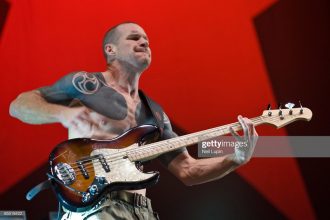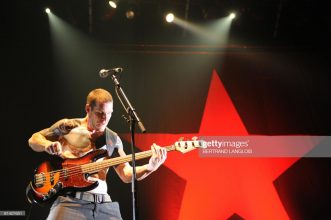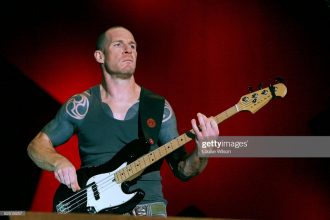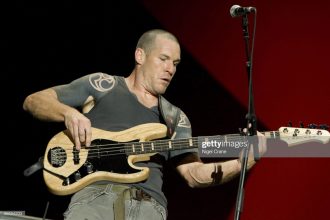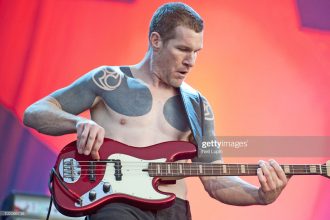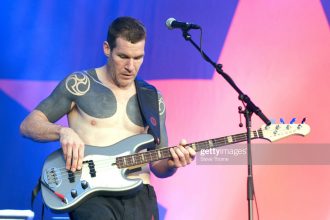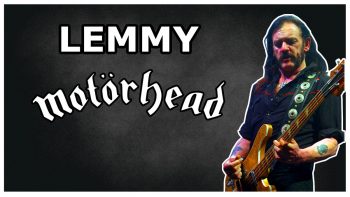Tim Commerford Bass Rig – Rage Against the Machine and Audioslave
In this post we take a historic look at the secretive Tim Commerford Bass Rig. Tim is the groove master behind Rage Against the Machine, AudioSlave and Prophets of Rage as well as countless others. Lets try and answer some of these age old mysteries. That just won’t go away on TalkBass.
Did you watch the video?! Would you like to know when the next one is out?
Tim Commerford early rig
Learning the guitar (1976)
The story starts with Zack De la Rocha. The would be front-man in Rage. He and Tim met at school around 1976 in Irvine California in the third grade. By the 6th grade aged around 11. Zack had inspired Tim to become a musician and taught him how to play bass parts on a nylon guitar. Tim would attribute his love of music to Zack. Mentioning;
“I gotta credit Zack to inspiring me to wanna play music, and play the bass guitar. I wouldn’t be here today if it weren’t for him.”
Tim Commerford on Prophets of Rage Audioboom.com
Tim’s earliest run in with a bass was at Rancho High School in San Joaquin California. He was inspired by the schools annual rock show but noticed a unique opportunity. The show had had guitar players and drummers. Yet the school caretaker filled in to play the bass.
“Given that few people played it, I thought it would be easier for me to get into the bands if I played it (the bass).
News Audioslaveitalia.com
Tim’s first bass and influences
His first bass was a Gibson G3 and took influence from the attitude of Sid Vicious from the Sex Pistols and the technicality of Rush’s Geddy Lee.
Tim’s first Stingray
In 1986, around about the age of 18. Tim acquired his first Stingray after taking inspiration from an instructional video by Louis Johnson*. He also hinted at playing a Rickenbacker and a Fender Jazz bass prior to Rage. However, neither show up in videos of early performances.
Tim Commerford Bass Rig in Rage Against the Machine
Formation of Rage Against the Machine (1991)
Rage Against the Machine formed in August 1991. With their first public performance 2 months later at Cal State university. Tim used his 2 band EQ natural finish Stingray and used it to record 1991’s self titled album*. He removed the pickguard and added a* small plastic thumb rest between the pickups. Thumb rests like this one continually appear throughout all of Tim’s basses.
The black Stingray backup
A second Stingray in black* was included on tour in 1993 as a backup. He wasn’t much of a fan of this bass citing;
“Every time I cracked a string on my old bass, I started to panic. “Oh, no, now I have to play the one black again, which does not sound so good.”
Tim Commerford Watkrat, Ratm, Audioslave … Gitarrebass.de
Tim’s natural finish Fender Jazz Bass
Tim held onto the main Stingray until 1995. When he was approached by Fender who asked him if he’d like to try one of their Jazz basses.
Arriving in a natural finish it too had the pickguard removed and a thumb rest added. In some of the festival footage during 1994 you can see what looks like a natural finish Fender Jazz sitting behind the amps. This natural finish bass took over the main duties and was used to record 1996’s Evil Empire.
In 2000 at the MTV Video Music Awards, the bass was smashed in protest after a Rage performance. The split coil pickups on this bass date back to 1970 and originate from England. Tim then rewound them by hand exclaiming they give him “more sustain and feedback”.
“I’m not looking for the cleanest sound in the world; I like that edgy, dirty tone. If you use different wire on your pickups, you’ll absolutely get a different sound.
Tim Commerford with Audioslave musicplayer.com
Once this bass was banged up. Tim had Fender Custom shop create copies which were used in Audioslave.
The rest of Tim’s Jazz Basses
Jazz Basses were seen live from 1996 until the last Rage show in September 2000. Apart from the natural finish there were two others. Mostly used as back ups and to switch turnings between songs.
- Black Fender jazz*. Seen a few times in 1997.
- 1974 Cream Fender Jazz*. (Maple fingerboard with black bar inlays)
- Sunburst Fender Jazz* (Briefly in the music video sleep now in the fire)
One interview states the cream Jazz as a 1974 Jazz. This is the only article which does so. It could be a reissue of some sort or the real deal. Another interesting article states Tim using an 8 string Rickenbacker recording Evil Empire*. Again, this is the only piece where the bass is mentioned.
Tim’s basses used in Rage Against the Machine (summary)
- Natural finish Stingray 4
- Black Stingray 4
- Natural finish Fender Jazz
- 1974 Cream Fender Jazz
- Black Fender Jazz
- 8 string Rickenbacker
Tim’s love of Jazz
Tim is a lover of love of Jazz music. He was inspired to buy two upright basses but nothing about their make or model.
I actually played upright bass for a while. They’re beautiful. It’s a sport. It takes muscles that need to get developed and practice every day. I brought it to a Rage rehearsal – and plugged it into an amp, it immediately started this low-end feedback and blew the front of the bass off the body. So it lasted all of five minutes and it was just destroyed and I had to have it repaired. And it has since gone back into storage.
Tim Commerford – Forbassplayersonly.com
Zack leaves Rage Against the Machine (2000)
Zack left the band in October 2000. Blaming a communication breakdown between the group for his departure. He concluded
“I feel that it is now necessary to leave Rage because our decision-making process has completely failed.
Shortly thereafter the album Renegades* was released in December the same year and mostly consisted of covers.
Tim Commerford bass rig in Audioslave
By Spring 2001 the remaining members of Rage sought to continue their musical direction without Zack. As timing would have it. Ex-front man Chris Cornell was finishing a solo tour.
Producer Rick Rubin suggested an ice-breaking jam session together. Cornell stated in an interview dated on 2003 “Within ten minutes of us just making stuff up and playing, it sounded incredible, we sounded like a band that had been together for a long time”.
After some initial disagreements with management everything soon worked out. Chris Cornell came up with the name Audioslave after talking to Tom Morello on the phone.
Recording Audioslave (2002)
Recording took place that summer with the self titled album “Audioslave*”. A Sadowsky Vintage Jazz was loaned and used on the record. Which was released on November 19, 2002. The bands’ first live debut came a few days later. Performing a brief concert on the roof of New York City’s Ed Sullivan Theater for the Late Show with David Letterman. Tim returns to light in this period with
- Black Jazz Bass (chrome pickguard and rosewood fingerboard) Seen on the Late Show
- Second Black Jazz (white pickguard and maple fingerboard). Seen on Cochise
The following Audioslave videos vary between the Jazz basses already mentioned. The 1974 Cream Jazz is seen in “Like A Stone” and “Show Me How To Live”.
The “Be Yourself” video shows the 1974 Cream, a black jazz with tortoise pickguard and a natural finish bass sitting in a stand. This looks to like original natural jazz bass. Now fitted with a tortoise pickguard.
Only on this bass did Tim have different types of pot controls. Sure the bass was dinged pretty hard *clip* but it didn’t break in two. And it’s clearly not “destroyed” as Tim stated in the past. The Audioslave world tour between 2003 and 2004 was more of the same. With Tim mainly playing the black chrome jazz and the natural bass for alt tuning.
Tim Commerford bass rig in Out of Exile tour (2004)
For the Out of Exile tour, there were some additions.
- Sunburst Fender Jazz* with a black pickguard
- Olympic white Fender Jazz with a tortoise pickguard.
- The black Jazz with the tortoise pickguard returned with a reverse headstock from a Precision bass.
The black Fender Jazz bass was tuned BEAD and Tim believed extending the length of B string would give him more sustain. Additionally precision necks were used for a larger spacing between strings. In an interview with Fender Tim stated;
“I’ve been playing Jazz basses with Precision Bass necks. and I’m almost thinking that I want to switch to Jazz Bass necks, because … it’s the most comfortable one for me”
Audioslave’s bassist talks Fender … Fender.com
It’s hard to tell with certainty which necks were Precision’s and more importantly when. Tim admits “I’m always changing up stuff and reevaluating what I’ve done.”
Recording Revelations (2006)
At the conclusion of the Out of Exile tour. Recording commenced for the bands third and final album Revelations*. Said to be used on the record is a Fender custom shop double neck Jazz Bass. The top half is tuned BEAD and the bottom E standard. It’s never been used live.
Cornell mentioned in an interview with Blabbermouth that he wanted to let fans “Spend some time with the album” before touring. A several month break of inactivity then ensued. Until 22 January 2007.
Rage Against the Machine announced plans to reunite for one show only at the Coachella Valley Music and Arts Festival. Taking place that April. Less than a month later, on 15 February 2007. Cornell officially announced his departure from Audioslave. Citing “musical differences”.
Rage Against the Machine Reunion (2007)
Rage took to the Coachella stage on 29 April 2007. Tim returned with a two tone (or Sunburst to you and me) Lakland Joe Osborne signature model with a pearloid pickguard.
Not to be confused with the Fender sunburst model which also appeared on the show with a black pickguard.
Ramping up into 2008 more shows ensued, with appearances at festivals throughout the world. Further Lakland basses joined the ranks. All of which were Joe Osborn signatures or what Lakland now call Vintage J’s. Speaking of Lakland … I like your new Geezer Butler page. Some of the grammar mistakes remind me of me own … Just saying.
Tim Commerford’s Laklands
- Sunburst (two tone) Joe Osborne signature with white pickguard
- Sunburst (two tone) Joe Osborne signature with tortoise pickguard
- Black Joe Osborne signature with white pickguard.
- Natural finish Joe Osborne signature
- Candy red Joe Osborne signature
- Inca silver Joe Osborne signature
There was no real rhyme or reason as and when these basses were played.
Rage breaks up – again
Even though Rage returned to a hungry audience. None of the band considered Rage their main musical focal point. With Tom Morello going as far as saying
“The Nightwatchman is my principal musical focus as I see it, for the remainder of my life”
No New RATM material planned The Guardian
Rage Against the Machines last, last show was performed in 2011 at the L.A. Rising festival. When asked about the future of Rage Tim responded “ It could be tomorrow; it could be 10 years from now”.
Tim Commerford bass rig in Future User
In 2014 Tim co-founded the band Future User. A Steinberger L2 can be seen in the video “Mountain Lion” and on the cover of December 2015’s bass player magazine. It was additionally used in Wakrat (see below) Tim stated in an interview that “This band was more about making art”. He continues;
You can take these beautiful synthesizers and we can connect them to the computer to make these incredible modulated keyboard lines we couldn’t do before. It’s inspiring, it’s an incredible tool. We’re making what I would consider progressive electronic music — we call it “progtronic”.
Futuer User Tim Commerford – Billboard.com
Tim Commford plays for Wakrat
Wakrat is a band Tim was asked to play for in 2015. He sings lead vocals and plays bass. Laklands were used to record the album and can be seen in interviews and early performances of the band.
Tim’s Music Man Stingray Special
By summer 2016 Tim was offered to try the new Music Man Stingray special. Stating he was approached by Brian Ball, grandson of Ernie Ball who wanted to make him a bass. Stingray Specials are rebuilt from the ground up and improves upon the Classic Ray 4. Featuring
- Neodymium pickups (and 5 point selector switch)
- 18 volt preamp
- New body contours
- Newly designed sculpted neck
The early wave of Stingray Specials saw the HS model. Humbucker – single configuration. Tim also states he modified his adding a string through bridge and mute pads. Stingray specials can be seen at the The Prophets of Rage shows and the One off Audioslave reunion in 2017. Since then he’s grown to collect 10 Stingrays in difficult configurations of woods and pickup types Through 2018-2019, his bass rig also includes HH models.
Tim Commerford plays Rickenbackers?
Photos from The Prophets of Rage Facebook show Tim using custom Rickenbackers in early 2017. The extent of their use has not been confirmed. Tim Commford’s Rickenbacker 1 – Natural finish, white pickguard and Stingray mute pad/bridge Tim Commford’s Rickenbacker 2 – White with bronze pickguard and dotted inlays
Tim Commerford bass rig and amplifiers in Rage Against the Machine
Before Tim started to Rage Against the Machine he was rocking a Fender 2×15″ cabinet with a matching Fender Bassman head*.
In one of the first public performances with Rage we can see two SWR Goliath 4×10″ cab. It most likely had a matching the SM900 head and he used this rig until May 1993.
Following this, we next see the appearance of an Ampeg 8×10″ and two 1×15″’s* underneath. Hidden out of view are two Ampeg SVT2 Pro’s and a third as a backup. If you’re into aesthetics, It’s around 2000 (and 2010) – the final Rage shows where the speaker cabs become torn and his amplifier rack holding the SVT2’s are spray painted.
Tim’s bass style, setup and amplifiers
Tim’s amplifiers aren’t just there to look cool and be loud. No, no. This actually fulfills an artistic purpose.
“I started realizing that my role had to do with how I’d play when Tom would solo-which he does quite often-or when he’s making weird noises. The bass was left alone as the only instrument playing melody, and I wanted it to be heard, so I knew I couldn’t just keep one tone happening through every song. I had to have some way of jumping it up and making it more exciting. So my role has been trying to fill the gap that a rhythm guitar player and bass player would normally fill.
Tim Commerford Breaks Out With Audioslave
Recording Evil Empire
When recording Evil Empire. Tim was adamant that dubbing rhythm guitar over solos didn’t sound right. They decided they needed the bass to occupy the same space as a guitar. However, when Tim hit his distortion pedal, there was a clear loss of bottom end in the sound.
Producer Brendan O’Brien suggested Tim get an A/B rig. One amp when punched in is solely dedicated to the distortion and the second amp always clean. He can then fulfill the whole sonic spectrum with his bass during solos instead of a second guitar.
Tim beamed at this discovery in an interview.
“When I hit the box, it’s like a second bass player joining the band. Every other bass player who hears it, they just go, ‘Oh, my God, that’s the most awesome sound I have ever heard.’ I only wish I would have done this five years ago.”
Notes from the underground – musicfanclubs.org
Bass amplifiers in Audioslave
During Audioslave, Tim makes further changes. Using two Ampeg 4×10“‘s*, one 4x10PR/HF and one 1×15”. Eventually the 15 inch was removed leaving behind the three 4×10″‘s. You’ll notice this rig is a bit lopsided as one of the cabs has a bass reflex port. It was around this time Tim played with the idea of improving the A/B set up. Adding a third SVT2 for another level of drive. Encompassing a clean sound, mild overdrive and full on distortion.
Changes in bass heads
By early summer 2003, Tim started experimenting with a Mesa M-Pulse 600 for his clean sound. Praising;
“The M-Pulse is sick for a clean tone, it is a great amp. I was having a hard time getting the B string to stand out and be as proud as the E on a regular bass. I now have an amp that can handle that low frequency.”
Regarding his distorted sound, he continues;
“I also got a new amp for distorted sound, the Ashdown ABM 500RC EVO. I keep the master volume at three-quarters and the gain up all the way so the VU meter doesn’t move; it’s hilarious. They sent me another one that’s a little hot-rodded so it can handle being in the red for the whole tour.”
Tim Commerford with Audioslave – Musicplayer.com
Tim Commerford bass rig in the Rage Against the Machine reunion
During the Rage reunion era he went back to the two 8x10s and SVT2s. Shortly thereafter in 2008, the amps were swapped for a pair of SVT VR’s* now sat on top of his amps A reissue of the early 1970s “Blue-Line” SVT. Which is built pretty much identically to the original amps. Tim’s a tinkerer so it’s believed these heads are modded. Not to mention an emphasis on the Telefunken tubes he installed. The SVT VR’s be sold by 2016.
Tim Commerford bass rig in Wakrat
Wakrat released an Introduction to the band video in 2015. In this video, the SVT2’s would make a return for a third time. In place of the VR’s was a now a pair of original classic SVTs. Tim dates them to 1975 but other sources claim 1978. The cabinets meanwhile were a throw back to the Audioslave era with two Ampeg 4×10″‘s and one PR410.
Tim Commerford bass rig in Prophets of Rage Barefaced
By the start of 2016 the Prophets of Rage had rose to bring about “an elite task force of revolutionary musicians” as Morello puts it.
That summer, British amplifier company Barefaced released a photo of Tim’s new cabinets just in time for the Prophets of Rage summer tour.
It consisted of;
- 8×10 powered by the 1975 SVT for the clean sound.
- 4×10 with an SVT2 for mid distortion
- 2×10 with an Orange AD200 for the noise. This replaced one of the SVT2s in September 2016.
Tim explained that “it (Orange AD200) is an incredible head for just going to that next level of overdrive. When I want to push it into a higher end, not going crazy but more into the white noise and the higher distortion.”
It wasn’t uncommon for Waktrat to open the show for the Prophets. Behind the Wakrat rig, you’ll see the Barefaced rig sat behind it. Meaning Tim uses a different rig for both bands..
Tim Commerford bass rig in 2019
Finishing up in present day – 2019. You’ll find Tim continues to uses the three tier Barefaced rig in its entirety.
Tim Commerford’s effects pedals
As most Commerford fans know already, Tim is absolutely silent about disclosing his tonal secrets. Even going as far as saying;
“I’m like the Pablo Escobar of bass, If a dude works on my gear, it’s almost like I have to kill him after he’s done. I don’t – but more than a few times I’ve told people, ‘if you let anyone know what you’ve done to my gear, I’m coming back.'”
Tim even reports that he puts decoy pedals on his board to throw off would be copy-cats.
The purpose of Tim’s effects pedals
Tim’s mentality when playing the bass is like a sport. The main goal is to fill the sonic space of both bass and rhythm guitar, during Morello’s guitar solos.
Originally, he did this by using a Marshall Guv’nor pedal. Used to replicate the classic Marshall tube Amp sound. This was the first guitar pedal designed by Marshal and was released in 1988.
In addition to this, Tim feeds his midrange sound with an Ernie Ball Jimi Hendrix distortion pedal. Up until Evil Empire these were primarily the only pedals he used in conjunction with a second driven SVT2.
Tim Commerford’s pedal board in Rage Against the Machine
Tim’s first pedal board is first seen in Rage Against the Machine in 1999. The silhouettes show about 6-7 pedals in total.
- Home made distortion box (Referred to as “Fear This”. It started off as a wah pedal and became a distortion pedal)
- Boss OC2*
- Boss DD-3*
- Dunlop 105Q bass wah*
- Ernie Ball volume pedal*
- Marshall Guv’nor pedal*
- Ernie Ball Jimi Hendrix distortion pedal
- DIY looper
- DIY ABY switcher
Tim Commerford’s pedal board in Audioslave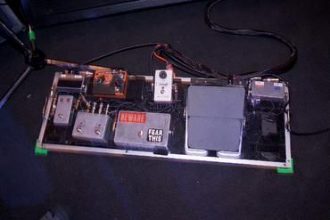
- Dunlop 105Q* bass wah (wired in parallel)
- Aphex Punch Factory compressor,
- MXR Micro amp*
- Fear This distortion box
- DIY ABY switcher
- DIY looper
- Inputs and outputs in the top left and right of the board
- A Peterson 5000 strobe tuner is seen on top of the amps.
Pedal board in Out of Exile (2005)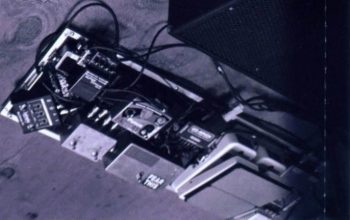
This picture comes from the inner cover of Out of Exile* released in 2005. The only real addition comes from the new Boss Super Octave, an upgrade from the OC2 and a Sadowsky preamp. The rest remains the same.
Effects on Dave Grohl’s Sound City (2010)
In 2010 Tim appears on Dave Grohl’s documentary Sound City. Brief glimpses of his pedals are shown.
- BOSS TU2 tuner*
- Electro Harmonix POG 2 octave *
- Electro Harmonix Octave Multiplexer*
- Two new homemade loopers
- Two DI’s pre and post board
The rest of the gear remains the same, As both of these images were taken during the recording sessions they could very well be situational.
Tim Commerford’s effect pedals in Wakrat
Gearing up into Wakrat around 2015. This was Tim’s initial board.
- DI
- Tech 21 Bass Driver*
- Ampeg SCRI
- Keeley C2 compressor.
Bass pedals and effects recording Wakrat
More footage of the band came out the following year with another glimpse of his board. Two new additions included
Wakrat bass pedals and effects on tour
When Wakrat started touring, Tim finally spoke openly about his gear. Firstly in a written interview. It states the usual gear as well as a return to the Marshall Guv’nor and MXR Phase 90. Neither of these pedals are seen live and could be studio based. The touring board consisted of a return to the Ampeg SCRI primarily used for in ear monitors.
- EBS compressor*
- Backup DIY distortion which is very similar to the “Fear This” box.
- DIY ABY box
- Line driver MXR*
- ABY MXR*
- Blue box fuzz MXR*
- COG effects analogue octave
- COG effects bass fuzz
- TC Helicon vocal preamp*
- Dunlop mini bass wah*
- Handmade A/B looper box.
- Ampeg Scrambler*
- Way Huge Purple Platypus*
Tim’s effects in Prophets of Rage
At the same time as this was going on. The Prophets of Rage were starting to gain traction. The primary focus of the Prophets is Rage Against the Machine songs. As a result, Tim has come full circle and uses some of his original gear. He returns with;
- Fear This
- Dunlop 105Q bass wah (x2)
- Boss OC2
- Boss DD3.
- Sound Blocks Mulitwave
- Orange two stroke distortion* (later swapped out for the sound block)
- MXR 10 band EQ*
- Way Huge 20th anniversary Red Llama / Green Rhino*
Tim Commerford’s strings and miscellaneous
Tim has primarily used Ernie Ball Slinkys 45-105’s* from the beginning. During the Audioslave era he cited in a 2005 interview that he’s gone through “a bunch of different string gauges” using a 45-,130B* on the first record. Kings X bassist Doug Pinnick suggested to Tim he use a lighter gauge instead. Dropping down to a 55-110* recording Out of Exile followed by a compromise of .40 – .120* when live.
“Now I feel like my J-Bass sounds like a J-Bass should, just with lower strings.” When recording Wakrat in 2016. Lakland basses were strung with Rotosound Tru Bass black nylons (.065–.115)*. Tim explained; “They’re the ones Paul McCartney used. It’s a cool sound and I was planning on using that live.”
Tim Commerford’s pickups
The original natural finish Jazz Bass pickups get a lot of attention. Which were sent to Fender Custom Shop to be replicated. In an interview with Fender. Tim expressed that he still has the Fender made pickups. When he’s having pickup issues he tends to try those out first.
“They’re always cool; they always work out. But I remember when I was A/B-ing them with the original ones. There’s something about those original ones that made them better than anything else. Those are the best two that I have.”
The Lakland vintage J’s have their own stock pickup. In comparison to the other Lakland basses fitted with Barotlini single coils. As Bartolinis tend to come stock on other Lakland models. Tim’s new Stingrays, depending on when you see them. Tend to have the new neodymium’s or Nordstrand Big mans.
Hipshot tuners
Other gear you’ll see Tim with are Hipshot tuners*. These replace the stock tuning key on your headstock with a little lever. When switched it will automatically drop the string to a designated position. For Tim this would mean dropping from E to D. You can tune back up to E and carry on by returning the level back to its starting position.
Tim Commerford’s bridges
Tim’s Fender Jazzes started out with Badass 2 bridges* and were eventually replaced with Gototh bridges. Tim stated he’s not a fan of stock bridges and the Gototh’s were solid. Only one of the Lakland’s had its bridge replaced and the rest remained stock. The same is mostly true for the Stingrays but a couple in his collections had modifications made to add a string thru bridge* with old school string mutes.
On the next Know Your Bass Player
We’re taking a look at Dave Ellefson from Megadeth. There’s also a possibility of some surprise updates heading your way. Stay tuned for that.
Submit your request
If you have a suggestion for a future episode you can Tweet me or leave a comment on YouTube. I want to hear it.
Watch more from Know Your Bass Player
Continue watching the most popular bass rig videos .
*Some of the links above are affiliate links, which means that if you choose to make a purchase from that site, we will earn a commission. As a result this commission comes at no additional cost to you and helps support our site and video series.

